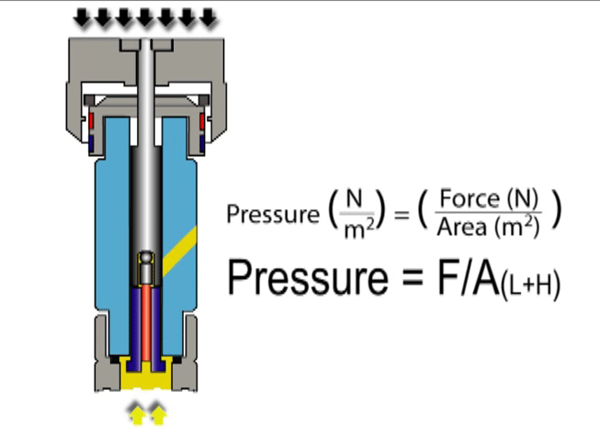The pressure range of a deadweight tester is limited by the effective area of the piston and the masses that are supplied. Smaller diameter pistons can generate larger pressures and larger diameter pistons can generate smaller pressures.
This becomes apparent when looking at the simple formula that describes how a deadweight tester generates pressure:
P= F/A
Where P = pressure under the piston, F = the force generated by the mass in a gravitational field stacked atop the piston, and A = the cross sectional area of the piston. Most deadweight testers have a single piston cylinder system with a set value for the cross sectional area of the piston "A," so "A" is constant. In the equation P=F/A, as "F" increases or decreases, "P" must follow suit:
F↑⇔P↑ , F↓⇔P↓
The only way to change the pressure under the piston is to stack more or less weights. A constant diameter piston limits the range that a deadweight tester can generate.
But what if there was a way to have a piston cylinder system that incorporated two pistons with two different cross sectional areas? That way, one mass set could generate a low pressure or a high pressure depending on which piston was engaged. Again in the equation P=F/A when "F" is constant, as "A" decreases, "P" has to increase, and as A increases, "P" has to decrease:
A↓⇔P↑ , A↑⇔P↓
There is a way forward: DH Budenberg deadweight testers and pressure balance models CPB5800, CPB5000 and CPB3800 can be equipped with a dual piston.

A dual piston greatly increases the range of these deadweight tester with only a single set of weights. These deadweight testers incorporate a small diameter, high pressure piston that rotates within a larger diameter, low pressure piston. The low pressure piston is active when at lower pressures, and as the pressure in the system increases to a given level, the low pressure piston becomes the cylinder in which the high pressure piston rotates. This provides two different, cross sectional areas in a single piston cylinder assembly, which allows the deadweight tester to generate two different pressures (low and high) with a single mass loading.
The video below shows a detailed animation of how this is accomplished.
Related Reading:

